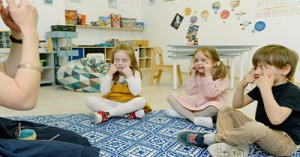In the early education context, assessment for learning is best practised as a “process of gathering and analysing information as evidence about what children know, can do and understand”, according to the EYLF. The approved learning framework is categorical that such assessment should be “part of an ongoing cycle that includes planning, documenting and evaluating”. Such ongoing processes lie at the heart of formative assessment practices. The following article provides information on What Is Formative Assessment Practices, Formative Assessment Regulatory Guidelines, and Benefits Of Formative Assessment and more.
What Are Formative Assessment Practices?
In early childhood settings, formative assessment is a process whereby educators collect evidence of children’s knowledge and skills in order to guide and tailor instruction and better support each child’s learning and development. These assessments are ongoing and provide information at the start of school and throughout the year as children continue to develop knowledge and new skills. The essential characteristics of formative assessment can be summarised:
- as ongoing and not conducted as a one-time occurrence like, at the end of a school term or set period as happens in summative assessment.
- it takes place during the regular course of instruction rather than requiring students to take a test in an artificial setting like an ‘exam hall’
- since it is a process, it can focus on one skill or on several aspects of children’s development. This can include emotional skills and children’s approaches to learning in addition to cognitive skills such as language, literacy, and math.
Formative Assessment and Regulatory Guidelines
The EYLF does not specify the exact forms that such assessment should take place in the ECEC setting; instead, the Educators’ Guide to the EYLF suggests that educators use a range of assessment tools and methods and even sets out criteria for the selection of such tools. Thus to guide Assessment Practice, the tools should meet the criteria:
- Ethical assessment – the tools should provide children with opportunities to confidently demonstrate their capabilities
- Dynamic assessment – the tools should assess children’s learning in the context of meaningful, supportive and respectful interactions
- Forward-thinking assessment – the tools should have the ability to assess children’s potential, rather than just their actual development/learning
- Child-oriented assessment – the tools and methods should allow children to assess themselves
In the case of content, Assessment should match the curriculum; in other words, the content of the assessment should be appropriate and not too time-consuming; it should assess important skills or understandings that are rich, complex and integrated.
Assessment is a key feature of the National Quality Standard to ensure the achievement of quality education and care by early childhood service providers. Assessment for children’s learning is highlighted in Quality Area 1, Educational Program and Practice. In Standard 1.3 specifies expectations from Assessment and Planning, particularly that “educators and co-ordinators take a planned and reflective approach to implementing the program for each child”. This is achieved by three Elements:
- 1.3.1 - Assessment and planning cycle: Each child’s learning and development is assessed or evaluated as part of an ongoing cycle of observation, analysing learning, documentation, planning, implementation and reflection. Element 1.3.1 is underpinned by National Regulation 74 Documenting of child assessments or evaluations for delivery of the educational programs.
- 1.3.2 - Critical reflection: Critical reflection on children’s learning and development, both as individuals and in groups, drives program planning and implementation.
- 1.3.3 - Information for families: Families are informed about the program and their child’s progress.
Benefits of Formative Assessment
The embedding of an ‘ongoing cycle of assessment’ both in NQS and EYLF underlines the importance of Formative Assessment in early childhood education and care. This form of assessment is considered especially suitable for young children because of the following reasons:
- Formative assessment is learner-centred and strengths-based, within the context of play-based learning. It allows educators to focus on children’s strengths and interests in a range of developmental and learning domains, rather than on what they don’t know and what educators think they should know. For this reason, formative assessment is also suitable for use with children with a range of abilities.
- Formative assessment can be used to inform learning goals and activities in the immediate future. Since it is ongoing, different forms of such assessment like observations, learning stories and reflections, help in continuing the program planning process for educators, rather than waiting for the beginning of the next term.
- Formative assessment is more responsive to and inclusive of, children’s engagement and voices as compared to one-time and strictly standardised assessment practices. Through the use of tools such as mind maps, floor books and photographs taken by children themselves, they have the opportunity to view and revisit their learning and thinking; in this way, the formative assessment makes it possible for children to be engaged.
- Formative assessment allows ample room for collaboration with families. This can be done by sharing documentation with families and inviting feedback or asking parents to provide a set of goals for the child at the start of the year. Formative assessment processes help educators to learn from families what the children are interested in and what activities they like - indeed children at times may bring to class something they have done at home which then can be used with other children.
Formative Assessment Tools
Here are some common tools of formative assessment used in the ECEC setting:
- Learning stories – These are narratives created from structured observations, designed to provide a cumulative series of pictures about a child’s learning. Once educators observe ‘critical incidents’ or moments of significance in a child’s development, they describe and analyse these experiences to arrive at an understanding of the trajectory of the child’s learning as well as the pattern of their learning style and dispositions. A learning story can exist on its own though it is usual for educators to link together several consecutive narratives for a fuller picture of the child’s learning
- Learning notes - As opposed to the time-intensive process and narrative format of learning stories, learning notes are shorter jottings that provide educators with a quicker, accurate description of an event, a comment interpreting the learning, and a brief outline of the next steps.
- Portfolios – these are one of the most effective ways to note changes in children’s skills and abilities over time and could demonstrate children’s progress. Portfolios can include a variety of assessment methods like observations, photos and samples of children’s work which in turn can include drawing, art, craft and even budding literacy skills like writing.
- Photographs – among the most popular methods of documentation, photographs are easy to use and suitable for children with a range of abilities or children who do not have English as their home language. They can be used to inform the writing of a Transition to School statement and for assessing children’s learning in relation to the EYLF Learning Outcomes. capturing a series of photos can document a child’s learning over time and make it easier to share with parents too. However, photographs should not replace the centrality of children’s own work samples.
- Floorbooks – This is a relatively recent early childhood educational approach that uses a large book with blank pages for children to record different aspects of their learning in small groups or as a whole class. Children draw pictures of what interests them or is related to what they have been learning; they put stickers or cut-out pictures and then glue them on the book; they write about their favourite topics, objects or feelings. Such images and drawings make children’s ideas clear and visible while their writings help them refine their own concepts.
- Daily journals that record children’s daily routines and experiences are yet another type of formative assessment tool. These can be used to record children’s interests and ideas, complemented with educators’ reflections.
- Checklists – Formative assessment need not include only subjective tools of assessment. They can also include more structured tools such as checklists. They may be standardised by regulatory bodies such as the school readiness checklist or designed by the service for its unique context. Such type of assessment can also include:
- Child-completed assessments, for example, checklists, drawings or work samples that include skills-related tasks, such as drawing shapes, or cutting shapes and pasting them onto a similar shape. These help educators to see where children are at, at that stage and what they may need to work on, such as scissor grip.
- Parent-completed assessments like ‘All about me’ forms; are completed by families at the beginning of the year these forms gather information from the family about the child’s interests, and strengths as well as their own goals and aspirations for their child.
- Developmental milestone checklist to identify children with developmental or learning difficulties, facilitating conversations with families about developmental/learning concerns as well as tracking change or progress in children’s development or learning.
- Individualised or personalised learning plans – These are designed according to a child’s interests, strengths, what children are working towards, and parent goals Examples are individual education plans (IEP) and early intervention plans for children with additional needs.
- Digital apps – Such digital assessment tools are not only flexible and creative, but the structure also assists educators to write their assessments of children’s learning besides allowing the opportunity to use videos and photos to document learning. Additionally, digital platforms make it easier to share documentation with parents who also get the space to provide comments. From the point of service view, digital apps are versatile and accessible throughout an entire service and can provide a central database of information.
Further Reading
The National Quality Standard and Elements - The following is a quick reference guide for educators that lists the standards and elements that apply to each quality area.
How To Achieve QA1 - The following is a list of outcomes under each element within QA1, that can help services identify if they are achieving Quality Area 1. It also includes documentation to support each element. This list can be used as a guide for Self-Assessment purposes and the development of the Quality Improvement Plan.
Observations in Childcare - The following article is a guide on how to write observations.
Different Types Of Observation Methods - The following article provides different types of observation methods that can be used to observe a child.
References:
Formative Assessment Practices In ECEC Settings In NSW, Department Of Education NSW
Formative Assessment Practices In Early Childhood Classrooms, Regional Educational Laboratory Program







 Here is the list of the EYLF Learning Outcomes that you can use as a guide or reference for your documentation and planning. The EYLF
Here is the list of the EYLF Learning Outcomes that you can use as a guide or reference for your documentation and planning. The EYLF The EYLF is a guide which consists of Principles, Practices and 5 main Learning Outcomes along with each of their sub outcomes, based on identity,
The EYLF is a guide which consists of Principles, Practices and 5 main Learning Outcomes along with each of their sub outcomes, based on identity, This is a guide on How to Write a Learning Story. It provides information on What Is A Learning Story, Writing A Learning Story, Sample
This is a guide on How to Write a Learning Story. It provides information on What Is A Learning Story, Writing A Learning Story, Sample One of the most important types of documentation methods that educators needs to be familiar with are “observations”. Observations are crucial for all early childhood
One of the most important types of documentation methods that educators needs to be familiar with are “observations”. Observations are crucial for all early childhood To support children achieve learning outcomes from the EYLF Framework, the following list gives educators examples of how to promote children's learning in each individual
To support children achieve learning outcomes from the EYLF Framework, the following list gives educators examples of how to promote children's learning in each individual Reflective practice is learning from everyday situations and issues and concerns that arise which form part of our daily routine while working in an early
Reflective practice is learning from everyday situations and issues and concerns that arise which form part of our daily routine while working in an early Within Australia, Programming and Planning is reflected and supported by the Early Years Learning Framework. Educators within early childhood settings, use the EYLF to guide
Within Australia, Programming and Planning is reflected and supported by the Early Years Learning Framework. Educators within early childhood settings, use the EYLF to guide When observing children, it's important that we use a range of different observation methods from running records, learning stories to photographs and work samples. Using
When observing children, it's important that we use a range of different observation methods from running records, learning stories to photographs and work samples. Using This is a guide for educators on what to observe under each sub learning outcome from the EYLF Framework, when a child is engaged in
This is a guide for educators on what to observe under each sub learning outcome from the EYLF Framework, when a child is engaged in The Early Years Learning Framework describes the curriculum as “all the interactions, experiences, activities, routines and events, planned and unplanned, that occur in an environment
The Early Years Learning Framework describes the curriculum as “all the interactions, experiences, activities, routines and events, planned and unplanned, that occur in an environment


